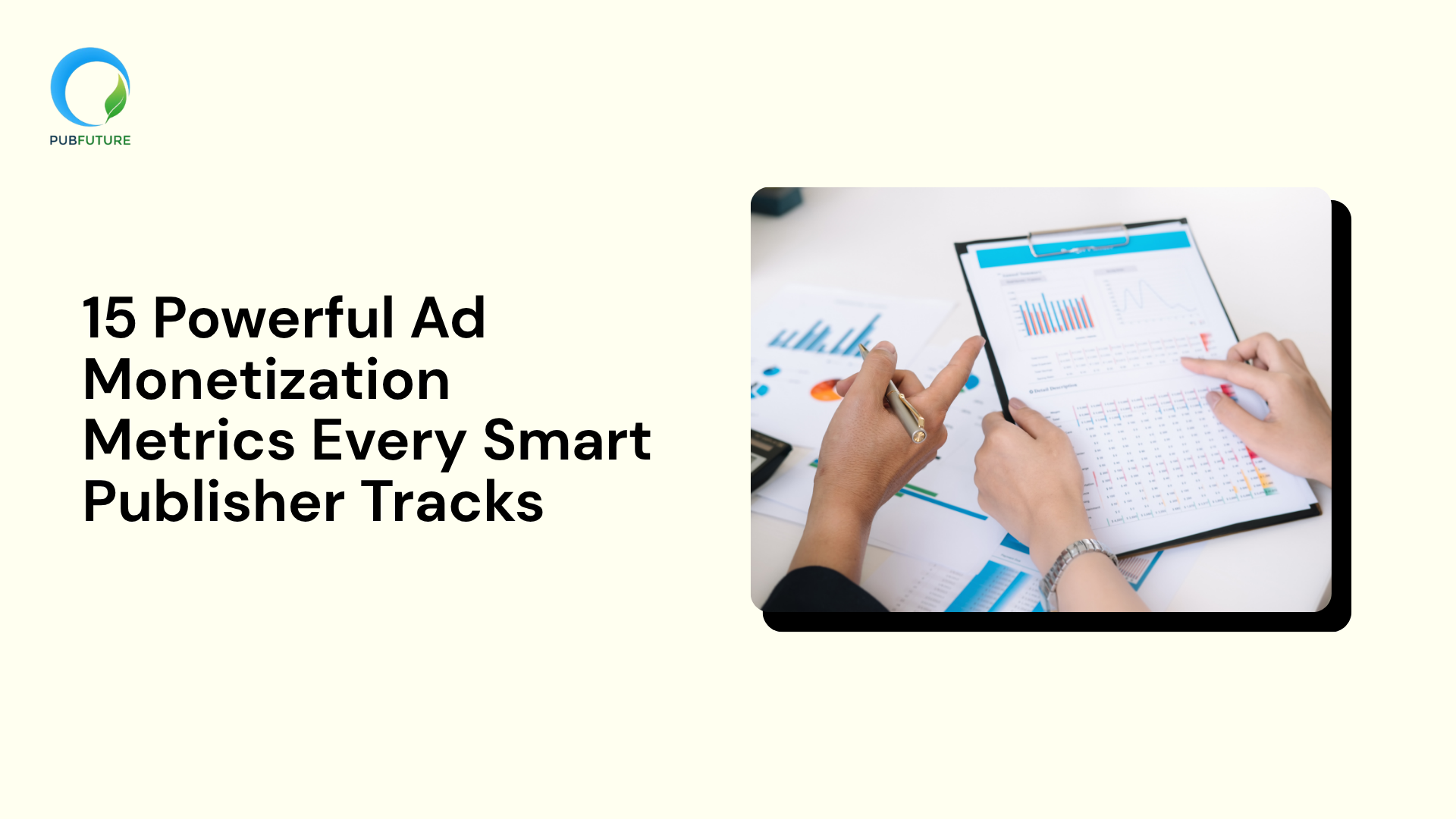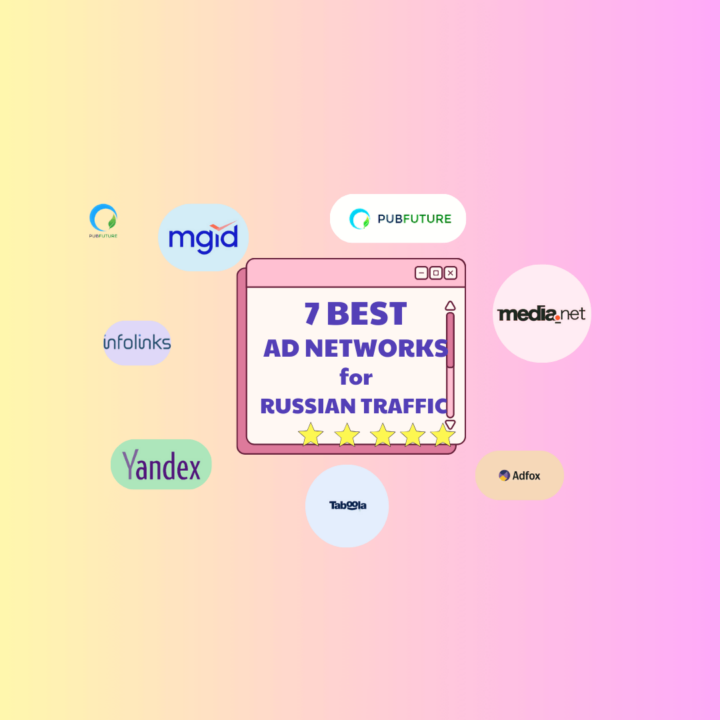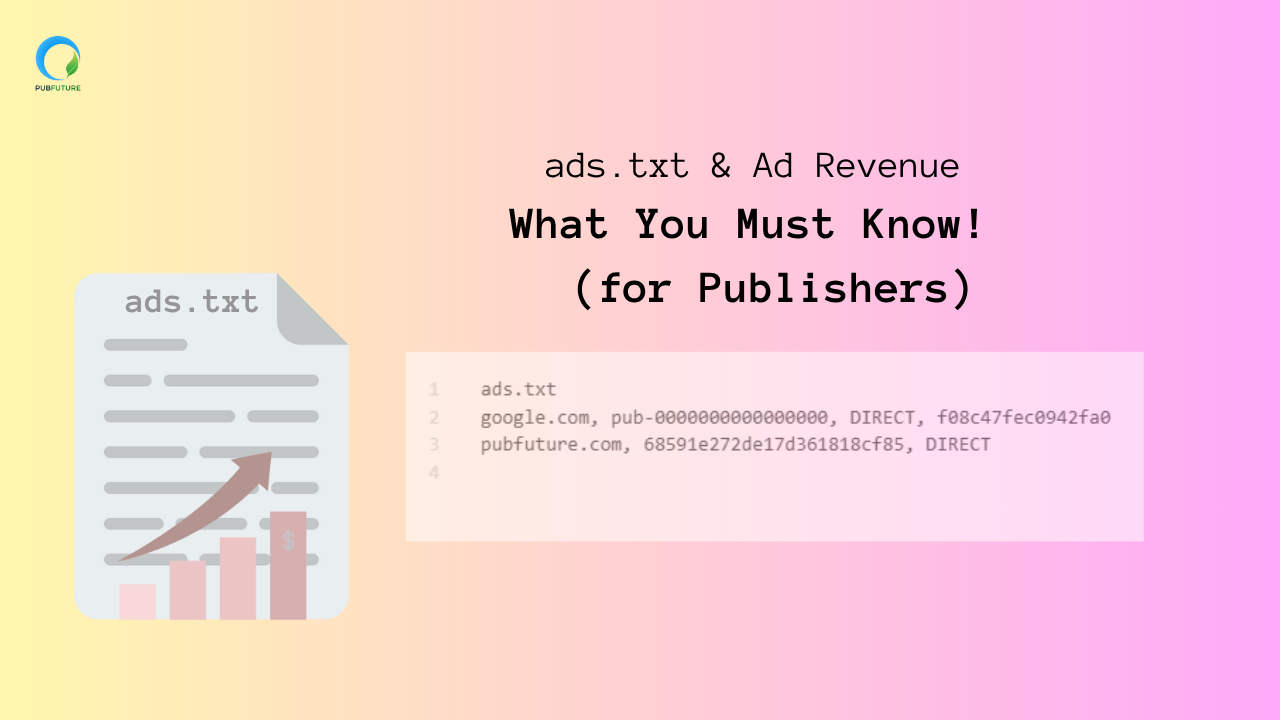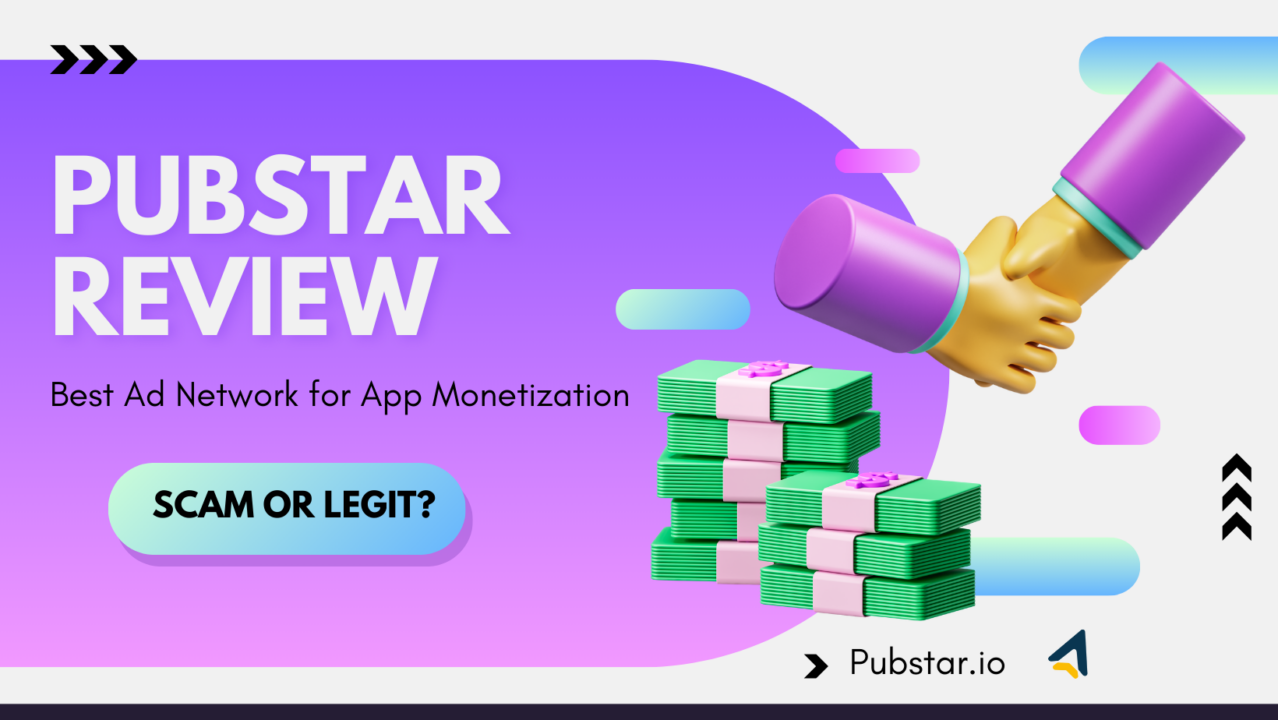Understanding and tracking the right monetization metrics is crucial for publishers who want to maximize ad revenue in the evolving programmatic landscape. Beyond simple traffic or total earnings, successful publishers rely on data-driven insights to measure the true value of every impression, session, and ad format.
In this article, Pubfuture explores the 15 most important monetization metrics every publisher should monitor — including clear definitions, formulas, and practical optimization tips.
1. eCPM (Effective Cost Per Mille)
eCPM measures how much you earn per 1,000 ad impressions.
Formula: eCPM = (Total Revenue / Total Impressions) x 1,000
For example, if you earned $50 from 50,000 impressions, your eCPM is $1.0. This metric helps compare performance across different placements, ad formats, or GEOs.
eCPM is affected by many factors, such as quality, safety, and demand for your inventory. To improve eCPM, publishers should experiment with high-impact ad formats like sticky ads or rewarded videos, target Tier-1 traffic, and use A/B testing to identify the most effective layouts.
2. Fill Rate
Fill rate measures the percentage of ad requests that are successfully filled with an ad. A low fill rate indicates missed revenue opportunities.
Fill Rate = (Filled Impressions ÷ Ad Requests) × 100
Healthy websites typically achieve 85–95% fill rate, while mobile apps average 75–90% (AdPushup, 2025).
Common causes of low fill rate include overly high floor prices, limited demand connections, or slow bid responses. To fix this, add more demand partners, implement header bidding, and adjust floor prices dynamically based on performance.
3. CTR (Click-Through Rate)
CTR measures the percentage of impressions that result in a click. While it doesn’t always correlate directly with revenue, it’s a strong indicator of ad relevance and user engagement. Current averages are 0.1–0.35% for display, 0.4–0.8% for native, and 0.6–1.2% for video ads (WordStream, 2024).
Improving CTR requires strong contextual alignment, viewable placements, and optimized ad creatives.
4. RPM (Revenue Per Mille)
RPM represents the total revenue generated per 1,000 pageviews — encompassing all monetization streams, including display, native, affiliate, and direct deals.
Tracking RPM helps assess overall site performance over time. If RPM drops while traffic stays constant, it’s a sign that ad yield or traffic quality needs improvement.
5. Session RPM
Session Revenue Per Mille (Session RPM) is a key monetization metric that measures the total revenue generated per 1,000 user sessions on a website. Unlike traditional RPM, which focuses on page views or ad impressions, Session RPM provides a more holistic view of how well a publisher monetizes a user’s entire visit.
Formula: Session RPM= (Total Revenue / Total Sessions) × 1,000
Session RPM captures total revenue across a user’s entire visit, reflecting the overall monetization strategy more accurately than metrics based solely on page views or impressions. Higher Session RPM often correlates with longer session durations, more page views, and increased user interaction, which typically drive more ad impressions and revenue.
To optimize session RPM, it helps to identify which types of content or user journeys generate the most revenue, guiding content creation and site optimization. For example, organic traffic may generate higher Session RPM compared to paid or social media traffic due to higher engagement levels.
Factors Influencing Session RPM:
- User Experience: A seamless browsing experience encourages users to stay longer, leading to higher Session RPM.
- Session Duration: Longer sessions give more opportunities to display ads, increasing potential revenue.
- Page Views Per Session: More page views naturally result in more ad impressions.
- Ad Density and Placement: The number and strategic positioning of ads during a session significantly impact monetization.
- Traffic Source Quality: High-intent traffic (e.g., from search engines) typically leads to more profitable sessions.
6. Viewability Rate
This metric measures the percentage of ads that are actually viewable to users. According to the Interactive Advertising Bureau’s (IAB) and Media Rating Council (MRC) standard, for an ad to count as viewed, 50% of it must be visible to a user for at least 1 second. For video ads, 50% of the ad must be visible for at least 2 seconds. Google refers to viewable impressions as ‘Active View‘.
However, different SSPs may use different viewability measurements. According to the internally sourced data from leading SSPs, the ideal ad viewability score should be above 70%. 50%-70% is acceptable. Below 50% is too low, so you must focus on your ad viewability. The higher the ad viewability rate, the better the performance and the demand for your inventory will be.
Formula: Viewability Rate (%) = (Viewable Impressions / Total Measurable Impressions) x 100
To improve viewability, prioritize above-the-fold placements, lazy loading, and sticky ad formats.
7. Bid Latency
Bid latency measures the time it takes (in milliseconds) for an ad request to receive a bid response. High latency reduces fill rate and harms user experience.
Industry best practice is below 300 milliseconds (Prebid.org, 2025).
To reduce latency, migrate to server-to-server (S2S) header bidding and remove unused bidders.
8. Ad Refresh Rate
Refresh rate tracks how frequently ads are refreshed on a page. After an initial ad is served, the ad slot refreshes based on a predefined time interval (e.g., every 30, 60, or 90 seconds). A new ad impression is counted each time the ad refreshes, generating additional revenue without needing the user to reload the page.
The ideal refresh interval is 30–60 seconds, depending on viewability and engagement (Google Ad Manager Help, 2025).
Focus on user-initiated or viewability-based refresh for compliance and performance.
9. Ad Refresh Revenue
Publishers leveraging ad refresh tactics must monitor the incremental revenue generated from ad refreshes separately from static impressions. This metric evaluates the effectiveness of refresh strategies and ensures they do not negatively impact user experience or violate viewability standards.
Formula: Ad Refresh Revenue Share (%) = (Total Ad Revenue / Revenue from Refreshed Ads) × 100
Refreshing ads increases the number of impressions per session, leading to higher total revenue without additional traffic. Long page visits or high engagement pages can display more ads, maximizing ad space efficiency.
If a publisher maintains high viewability rates and serves ads only when they’re in view (using viewability-triggered refresh), demand partners may potentially bid even more on refreshed impressions, improving competition and raising CPMs.
10. Timeout Rate
The Timeout rate measures the percentage of bid requests that fail to return within the set timeout window. A high timeout rate suggests that demand partners are either slow to respond or that the timeout settings are too aggressive. Optimizing timeout settings and collaborating with faster demand partners can help reduce this rate and capture more bid opportunities.
Formula: Timeout Rate (%) = (Timed-Out Bids / Total Bid Requests) x 100
There are many factors that influence timeouts, such as network latency, bidder response time, page latency, and others. A good rule of thumb to keep in mind about the timeouts is the following:
- If the timeout is too short, bidders may not have enough time to submit their bids, leading to fewer bids and lower revenue.
- If the timeout is too long, it can cause delays in ad serving, reducing the number of auctions that can be conducted and possibly frustrating users.
11. Bid Density
Bid Density measures the average number of bids received per auction in a programmatic advertising setup, particularly in header bidding environments. It indicates how competitive the demand is for a publisher’s ad inventory.
Formula: Bid Density = Total Bids / Total Auctions
A higher bid density means more demand partners are competing for the same ad slot, leading to higher CPMs and better monetization. It helps publishers assess how engaged their demand partners are. Low bid density may suggest underperforming partners or technical issues.
Factors Influencing Bid Density:
- Number of Demand Partners: More connected SSPs and DSPs typically increase bid density.
- Ad Placement and Format: High-impact placements (e.g., above-the-fold) often attract more bids.
- Floor Prices: If floor prices are too high, fewer bidders will participate, lowering bid density.
- Timeout Settings: Short timeouts may exclude slower bidders, reducing density.
A healthy bid density fosters competitive bidding, but excessive demand partners can slow down the page and lead to latency issues. Every publisher should experiment to find out the perfect number of bidders for their website.
12. Session Revenue Per Mille (Session RPM)
Session Revenue Per Mille (Session RPM) is a key monetization metric that measures the total revenue generated per 1,000 user sessions on a website. Unlike traditional RPM, which focuses on page views or ad impressions, Session RPM provides a more holistic view of how well a publisher monetizes a user’s entire visit.
Formula: Session RPM= (Total Revenue / Total Sessions) × 1,000
Session RPM captures total revenue across a user’s entire visit, reflecting the overall monetization strategy more accurately than metrics based solely on page views or impressions. Higher Session RPM often correlates with longer session durations, more page views, and increased user interaction, which typically drive more ad impressions and revenue.
To optimize session RPM, it helps to identify which types of content or user journeys generate the most revenue, guiding content creation and site optimization. For example, organic traffic may generate higher Session RPM compared to paid or social media traffic due to higher engagement levels.
Factors Influencing Session RPM:
- Session Duration: Longer sessions give more opportunities to display ads, increasing potential revenue.
- Page Views Per Session: More page views naturally result in more ad impressions.
- Ad Density and Placement: The number and strategic positioning of ads during a session significantly impact monetization.
- Traffic Source Quality: High-intent traffic (e.g., from search engines) typically leads to more profitable sessions.
- User Experience: A seamless browsing experience encourages users to stay longer, leading to higher Session RPM.
13. Bid Latency
Bid latency measures the time it takes for a demand partner (such as an SSP or DSP) to respond to a bid request during a programmatic auction, particularly in header bidding setups. This response time is typically measured in milliseconds (ms).
High bid latency can delay page loading and ad rendering, negatively affecting the user experience. Slow bidders can cause auctions to timeout, leading to missed revenue opportunities.
On the contrary, lower latency ensures more bids are considered in the auction, increasing competition and potentially boosting CPMs. It helps to continuously monitor bid latency helps identify underperforming or slow demand partners that may need optimization or removal.
Best Practices to Reduce Bid Latency
- Optimize Timeout Settings: Set realistic timeouts that allow responsive bidders to participate while minimizing delays.
- Evaluate Demand Partners: Regularly assess and remove slow or underperforming partners.
- Geo-Targeting Bidders: Match demand partners with server locations closer to your primary audience. Setupad Self-Serve platform has built-in infrastructure for geo-targeting, serving ads from the nearest Cloudflare edge locations.
- Leverage Server-to-Server (S2S) Integrations: S2S connections often reduce latency compared to client-side setups.
- Monitor and Adjust Wrapper Configuration: Avoid adding too many bidders to the wrapper, which can overwhelm the auction process.
- Use Asynchronous Loading: Load ads independently of page content to minimize delays.
Optimal Bid Latency Range
- Below 200ms is ideal for most header bidding setups.
- Above 500ms often leads to timeouts and poor auction performance.
14. Page Revenue Per Mille (Page RPM)
Page RPM (Revenue Per Mille) is a key monetization metric that measures how much revenue a publisher earns for every 1,000 page views. It provides insight into how effectively individual web pages are generating ad revenue.
Formula: Page RPM= (Total Page Views / Total Revenue) x 1,000
Page RPM shows how much revenue each page view generates, helping publishers assess the performance of their content and ad strategy. It allows publishers to identify which pages or types of content are generating the most revenue, enabling data-driven content and monetization strategies.
This metric highlights how well ad placements, formats, and density contribute to earnings on a page-by-page basis.By analyzing Page RPM, publishers can pinpoint underperforming pages and optimize them to boost revenue.
Page RPM vs. Session RPM
- Page RPM: Measures revenue per 1,000 page views, focusing on individual page performance.
- Session RPM: Measures revenue per 1,000 user sessions, reflecting overall user engagement across multiple pages.
Page RPM gives publishers detailed insights into the revenue performance of each page, while Session RPM offers a broader view of how entire user sessions contribute to revenue.
15. Bid & Win rate
Bid rate and win rate are two critical metrics in programmatic advertising and header bidding setups that help publishers assess the performance and competitiveness of their demand partners in real-time auctions.
A high bid rate indicates strong participation and interest in your inventory. A low bid rate can signal technical misconfigurations, connectivity issues, or poor inventory matching.
Similarly, a high win rate suggests that a bidder is placing competitive bids and is a valuable partner. A low win rate may indicate that bids are too low or that floor prices are set too high.
Publishers can use win rate data to assess which partners are worth prioritizing or removing.
Interpreting Bid Rate and Win Rate Together
- High Bid Rate + High Win Rate: The partner is highly engaged and competitive. This demand partner likely adds significant value and should be prioritized.
- High Bid Rate + Low Win Rate: The partner is active but losing most auctions. This could indicate weak bids, high floor prices, or misalignment with inventory. Optimization may be needed.
- Low Bid Rate + High Win Rate: The partner bids selectively but effectively. It might make sense to encourage more participation through better alignment or custom deals.
- Low Bid Rate + Low Win Rate: The partner is underperforming. Review technical setups, targeting, or consider removing them.
Conclusion:
To thrive in the competitive digital publishing landscape, relying solely on traditional monetization metrics isn’t enough. By focusing on deeper, more nuanced indicators like viewability, refresh revenue, demand distribution, and Prebid-specific metrics such as bid latency and timeout rate–while not neglecting essentials like eCPM and fill rate–publishers can make data-driven decisions that optimize revenue streams and ensure long-term growth. Strategic monitoring and proactive adjustments will unlock significant monetization potential.









